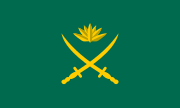Bangladesh Army
| Bangladesh Army | |
|---|---|
| বাংলাদেশ সেনাবাহিনী Bānglādēśh Sēnābāhinī |
|

Badge of the Bangladesh Army
|
|
| Active | 26 March 1971–present |
| Country | Bangladesh |
| Allegiance | Constitution of Bangladesh |
| Type | Army |
| Part of | Bangladesh Armed Forces |
| Army Headquarters | Dhaka Cantonment |
| Nickname(s) | BA/BD Army |
| Motto(s) | "In War, In Peace We are Everywhere for our Country" (সমরে আমরা শান্তিতে আমরা সর্বত্র আমরা দেশের তরে) |
| Colors | Black, Green |
| March | Chol Chol Chol (চল চল চল) |
| Mascot(s) | Crossed scimitars |
| Anniversaries | Armed Forces Day (21 November) |
| Engagements | |
| Decorations |
|
| Website | Official website |
| Commanders | |
| Minister of Defence | Hon. Prime Minister Sheikh Hasina |
| Chief of Army Staff | General Abu Belal Muhammad Shafiul Haque |
| Insignia | |
| Flag of the Bangladesh Army | |
| Aircraft flown | |
| Helicopter | AS365 Dauphin, Bell 206, Mi-171 |
| Trainer | Cessna 152 |
| Transport | Cessna 208B, EADS CASA C-295 |
The Bangladesh Army (BA, Bengali: বাংলাদেশ সেনাবাহিনী, Bangladesh Senabahini) is the land forces branch and the largest of the three uniformed service of the Bangladesh Armed Forces. The primary mission of the Army is to provide necessary forces and capabilities in support of Bangladesh's security and defence strategies including defence of the nation's territorial integrity against external attack. Control and operations are administered by the Department of the Army of the Armed Forces Division. The civilian head is the Prime Minister, who by law also holds the defence ministry portfolio. In addition to its primary mission the Bangladesh Army is also constitutionally obligated to assist the civilian government during times of national emergency. This role is commonly referred to as "aid to civil administration".
The martial tradition of Bengal has its roots in the during Mughal rule since the early 18th century, when three successive Muslim dynasties, namely the Nasiri, Afshar and Najafi, ruled Bengal. During the Colonial Rule of the British, Bengal was principally a bulwark of British power and trade in the South Asian region. The British under Robert Clive defeated a 50,000 strong Bengal Army of Nawab Siraj-ud-daullah in the Polashey(Plassey) in 1757 and later the forces of Nawab Mir Qasim at the Battle of Buxar in 1764. The Army of Bengal was formed, which later became part of a united Indian Army from 1895 to 1947. The eastern part of the region was a prominent place for military and police recruitment, with entire horse-mounted cavalry and lancer units being recruited there prior to the Bengal Sepoy Mutiny of 1857. Post-mutiny, units with the epithet "Bengal" in their name, such as Bengal Sappers and Bengal Cavalry, were largely recruited from non-Bengali peoples from Bihar, Varanasi and Uttar Pradesh which were technically still part of Bengal Presidency at that time.
...
Wikipedia

